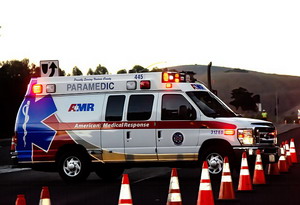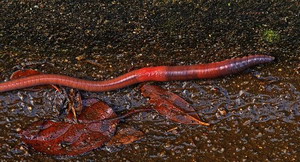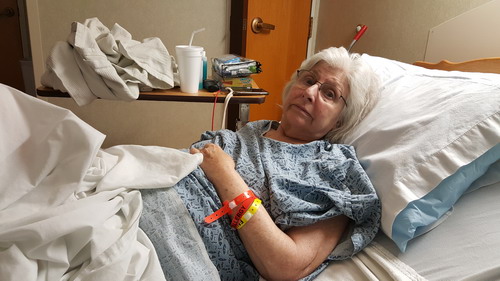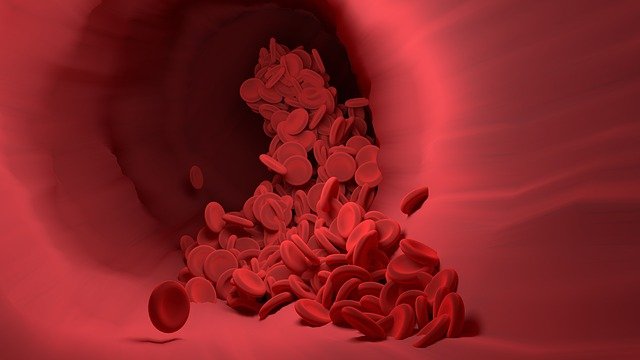 Back in the middle of the night on February 15th of 2015, Ellen woke me up in distress because she suddenly could not feel the left side of her body and her vision was blurry. Half awake I asked if she meant just the left arm or leg. She replied that she couldn’t feel either and that she felt something was terribly wrong. That popped me wide awake. Just an arm or a leg would probably be something “out” in her low back or neck – everyday stuff for me. But both at once set the alarm off in my brain that this was probably a central nervous system disorder. The most common CNS disorder to come on so quickly would be a stroke.
Back in the middle of the night on February 15th of 2015, Ellen woke me up in distress because she suddenly could not feel the left side of her body and her vision was blurry. Half awake I asked if she meant just the left arm or leg. She replied that she couldn’t feel either and that she felt something was terribly wrong. That popped me wide awake. Just an arm or a leg would probably be something “out” in her low back or neck – everyday stuff for me. But both at once set the alarm off in my brain that this was probably a central nervous system disorder. The most common CNS disorder to come on so quickly would be a stroke.
 I popped up and performed the basic stroke exam. First I asked her to smile and then stick her tongue out. One side of her mouth drooped – not a good sign and her tongue pulled to one side. I asked her to raise both arms – she couldn’t raise her left arm. I asked her who the president was and what day of the week it was – she was okay with those. With these questions, I was assessing both her present time awareness, memory, and speech ability. Her speech was not slurred. I moved my hand side to side in front of her face to see if she could track my movement with her eyes. She was seeing double, so tracking was difficult. I grabbed the phone and dialed 911 to report a stroke and get an ambulance as quickly as possible. Problems with any of these tests could indicate a stroke. In her case, the tests told me that her stroke was in her brain stem where movement is controlled, but not up in her speech areas or memory in the front part of her brain…at least not yet.
I popped up and performed the basic stroke exam. First I asked her to smile and then stick her tongue out. One side of her mouth drooped – not a good sign and her tongue pulled to one side. I asked her to raise both arms – she couldn’t raise her left arm. I asked her who the president was and what day of the week it was – she was okay with those. With these questions, I was assessing both her present time awareness, memory, and speech ability. Her speech was not slurred. I moved my hand side to side in front of her face to see if she could track my movement with her eyes. She was seeing double, so tracking was difficult. I grabbed the phone and dialed 911 to report a stroke and get an ambulance as quickly as possible. Problems with any of these tests could indicate a stroke. In her case, the tests told me that her stroke was in her brain stem where movement is controlled, but not up in her speech areas or memory in the front part of her brain…at least not yet.
 She was rushed to the hospital where they did all sorts of brain scans. Normally they immediately put stroke patients on clot-busting drugs to break up the clot and re-establish blood flow to the oxygen-starving areas of the brain. Unfortunately, Ellen’s blood clot was so huge that they did not want to break it up because the smaller pieces would just travel up higher into her brain and block the brain areas that affect her speech, memory, and who knows how much else. Basically, the hospital did nothing but wait it out. Gradually the repeated brain scans showed that her body slowly dissolved the clot, but not before a huge area of her brain stem, called the pons, was destroyed. Once the clot dissolved on its own, they started Ellen on blood thinners – Warfarin. For those of you in the know, this is the same stuff used in rat poison. In small doses, it stops the clotting process in the blood. In higher doses, it will actually cause you to hemorrhage. That is how it kills rats.
She was rushed to the hospital where they did all sorts of brain scans. Normally they immediately put stroke patients on clot-busting drugs to break up the clot and re-establish blood flow to the oxygen-starving areas of the brain. Unfortunately, Ellen’s blood clot was so huge that they did not want to break it up because the smaller pieces would just travel up higher into her brain and block the brain areas that affect her speech, memory, and who knows how much else. Basically, the hospital did nothing but wait it out. Gradually the repeated brain scans showed that her body slowly dissolved the clot, but not before a huge area of her brain stem, called the pons, was destroyed. Once the clot dissolved on its own, they started Ellen on blood thinners – Warfarin. For those of you in the know, this is the same stuff used in rat poison. In small doses, it stops the clotting process in the blood. In higher doses, it will actually cause you to hemorrhage. That is how it kills rats.
 Could this have been prevented? Probably, yes. This is one of those 20/20 hindsight issues. If we had suspected that this could be an issue, we could have guarded against it by taking fibrinolytic enzymes each day. There are many ways to stop the clotting of blood because the formation of clots involves several steps. Aspirin interferes with the platelets, the blood clotting parts of the blood, by keeping them from sticking together. Warfarin inactivates the vitamin K in your blood, which is necessary for clots to form. (K is also necessary for you to form bone tissue.) The clots themselves are made from sticky protein ropes called fibrin. Fibrinolytic enzymes break down the fibrin that forms the clots. Fibrin not only forms clots, but it is also a key component of scar tissue and is well known for forming those tough gritty knots that glue muscles together after muscle strains. Fibrin also appears to be key in starting the inflammatory processes in arthritis. Some fibrin is essential so that we can heal from injuries. The problem with fibrin is that it is too tight and tough to let blood vessels into the area. This prevents the formation of good healthy replacement tissue and leaves scars instead.
Could this have been prevented? Probably, yes. This is one of those 20/20 hindsight issues. If we had suspected that this could be an issue, we could have guarded against it by taking fibrinolytic enzymes each day. There are many ways to stop the clotting of blood because the formation of clots involves several steps. Aspirin interferes with the platelets, the blood clotting parts of the blood, by keeping them from sticking together. Warfarin inactivates the vitamin K in your blood, which is necessary for clots to form. (K is also necessary for you to form bone tissue.) The clots themselves are made from sticky protein ropes called fibrin. Fibrinolytic enzymes break down the fibrin that forms the clots. Fibrin not only forms clots, but it is also a key component of scar tissue and is well known for forming those tough gritty knots that glue muscles together after muscle strains. Fibrin also appears to be key in starting the inflammatory processes in arthritis. Some fibrin is essential so that we can heal from injuries. The problem with fibrin is that it is too tight and tough to let blood vessels into the area. This prevents the formation of good healthy replacement tissue and leaves scars instead.
 In Europe, first responders /EMTs will administer a fibrinolytic enzyme called nattokinase as soon as they arrive on the scene to prevent further clotting. That is not done in this country. In the hospital, they may administer another fibrinolytic enzyme called streptokinase. Why the difference? Money. Nattokinase is derived from the soybean product natto and is, therefore, a natural substance, while streptokinase is lab-made and therefore a patentable medicine. American medicine restricts itself to patent medicines only and avoids the less costly natural substances. The good news for us is that as a natural substance, nattokinase can be sold to us common folks as a supplement. Once we got Ellen out from under the treatment protocols followed during the acute stages of her stroke care, we started her on a daily regime of nattokinase instead of the more toxic blood thinners offered her. When Ellen was in a care facility for a fall for a few weeks, I was surprised that they actually took the nattokinase I brought them and approved their staff giving it to her instead of the regular blood thinners they wanted to use.
In Europe, first responders /EMTs will administer a fibrinolytic enzyme called nattokinase as soon as they arrive on the scene to prevent further clotting. That is not done in this country. In the hospital, they may administer another fibrinolytic enzyme called streptokinase. Why the difference? Money. Nattokinase is derived from the soybean product natto and is, therefore, a natural substance, while streptokinase is lab-made and therefore a patentable medicine. American medicine restricts itself to patent medicines only and avoids the less costly natural substances. The good news for us is that as a natural substance, nattokinase can be sold to us common folks as a supplement. Once we got Ellen out from under the treatment protocols followed during the acute stages of her stroke care, we started her on a daily regime of nattokinase instead of the more toxic blood thinners offered her. When Ellen was in a care facility for a fall for a few weeks, I was surprised that they actually took the nattokinase I brought them and approved their staff giving it to her instead of the regular blood thinners they wanted to use.
 Many people tell me that they use baby aspirin to prevent clots. This is helpful, but regular use of any NSAID drug, like aspirin, has many downsides like liver, kidney, stomach, and intestinal damage. In fact, the AMA decided that the use of baby aspirin was no longer approved for this purpose as the risks were not outweighed by the benefits. Other blood thinners all have a long list of negative side effects. Nattokinase, in the appropriate doses, has no known side effects. However, since it does affect the blood, you should use caution if you have a bleeding disorder like hemophilia, low blood pressure, or if you are already taking other blood thinners or blood pressure-lowering drugs.
Many people tell me that they use baby aspirin to prevent clots. This is helpful, but regular use of any NSAID drug, like aspirin, has many downsides like liver, kidney, stomach, and intestinal damage. In fact, the AMA decided that the use of baby aspirin was no longer approved for this purpose as the risks were not outweighed by the benefits. Other blood thinners all have a long list of negative side effects. Nattokinase, in the appropriate doses, has no known side effects. However, since it does affect the blood, you should use caution if you have a bleeding disorder like hemophilia, low blood pressure, or if you are already taking other blood thinners or blood pressure-lowering drugs.
Other uses for nattokinase include:
Angina
Arthritis
Atherosclerosis
Deep vein thrombosis
Dementia from poor blood flow
Hemorrhoids
Hypertension
Myocardial infarction (heart attack)
Peripheral artery disease
Stroke
Varicose veins
 All these concerns involve issues with the good flow of blood except the arthritis. Fibrosis in the arteries, due to tiny damages in the artery walls, can block up blood flow slowly over time, unlike the clot in a stroke or heart attack which happens all at once. Fibrin buildup initially serves its purpose, but without help from substances like nattokinase, it tends to hang around and eventually causes problems. It is an example of how the body prioritizes survival in the moment over long-term health.
All these concerns involve issues with the good flow of blood except the arthritis. Fibrosis in the arteries, due to tiny damages in the artery walls, can block up blood flow slowly over time, unlike the clot in a stroke or heart attack which happens all at once. Fibrin buildup initially serves its purpose, but without help from substances like nattokinase, it tends to hang around and eventually causes problems. It is an example of how the body prioritizes survival in the moment over long-term health.
 Another fibrinolytic enzyme similar to nattokinase but believed to be much stronger is lumbrokinase. This one is also from a natural source, although when I tell folks where it comes from they usually get squeamish about it. It is from a particular form of earthworm – the lumbricus rubellus. They actually dry and grind up the earthworms and put them in capsules. Sounds yummy to me… must be the keto diet getting to my brain. Here is a good article about both enzymes: https://www.clinicaleducation.org/resources/reviews/potent-natural-fibrinolytic-enzymes-safely-reduce-clotting-risk/
Another fibrinolytic enzyme similar to nattokinase but believed to be much stronger is lumbrokinase. This one is also from a natural source, although when I tell folks where it comes from they usually get squeamish about it. It is from a particular form of earthworm – the lumbricus rubellus. They actually dry and grind up the earthworms and put them in capsules. Sounds yummy to me… must be the keto diet getting to my brain. Here is a good article about both enzymes: https://www.clinicaleducation.org/resources/reviews/potent-natural-fibrinolytic-enzymes-safely-reduce-clotting-risk/
 So, if you have high blood pressure that makes you a good candidate for a stroke. If you have sluggish blood causing any of the conditions mentioned above, consider making nattokinase a regular part of your daily supplement support. If we had done that with Ellen, she would most likely not be in the condition she is in with her left-sided partial paralysis. I can tell you from personal experience that living with the lasting effects of a stroke is a serious challenge. If you can avoid it I would.
So, if you have high blood pressure that makes you a good candidate for a stroke. If you have sluggish blood causing any of the conditions mentioned above, consider making nattokinase a regular part of your daily supplement support. If we had done that with Ellen, she would most likely not be in the condition she is in with her left-sided partial paralysis. I can tell you from personal experience that living with the lasting effects of a stroke is a serious challenge. If you can avoid it I would.
Take care,
David
